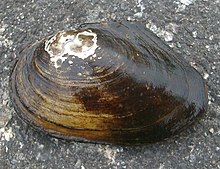Unionoida
| Unionoida | |
|---|---|
 |
|
| A live individual of Anodonta anatina, the duck mussel | |
| Scientific classification | |
| Kingdom: | Animalia |
| Phylum: | Mollusca |
| Class: | Bivalvia |
| Subclass: | Palaeoheterodonta |
| Order: |
Unionoida Stoliczka, 1871 |
| Families | |
|
See text |
|
See text
Unionoida is an monophyletic order of freshwater mussels, aquatic bivalve molluscs. The order includes most of the larger freshwater mussels, including the freshwater pearl mussels. The most common families are the Unionidae and the Margaritiferidae. All have in common a larval stage that is temporarily parasitic on fish, nacreous shells, high in organic matter, that may crack upon drying out, and siphons too short to permit the animal to live deeply buried in sediment.
The shells of these mussels are variable in shape, but usually equivalve and elongate. They have solid, nacreous valves with a pearly interior, radial sculpture, and an entire pallial line.
Families, genera, and species in the order Unionoida are found on six continents, where they are restricted exclusively to freshwater rivers, streams, creeks and some lakes. There are approximately 900 species worldwide. Around 300 species of these freshwater mussels are endemic to North America.
Unionoida burrow into the substrate in clean, fast flowing freshwater water rivers, streams and creeks, with their posterior margins exposed. They pump water through the incurrent aperture, obtaining oxygen and filtering food from the water column. Freshwater mussels are some of the longest-living invertebrates in existence. These clams have, like all bivalve mollusks, a shell consisting of two parts that are hinged together, which can be closed to protect the animal's soft body within. Like all mollusks, the freshwater mussels have a muscular "foot", which enables the mussel to move slowly and bury itself within the bottom substrate of its freshwater habitat.
Unionoida have a unique and complex life cycle involving parasitic larvae. This larval form used to be described as "parasitic worms" on the fish host, however, the larvae are not "worms" and do not harm fish under normal circumstances. Most of these freshwater mussel species have separate sexes (although some species, such as Elliptio complanata, are known to be hermaphroditic). The sperm is ejected from the mantle cavity through the male's excurrent aperture and taken into the female's mantle cavity through the incurrent aperture. Fertilised eggs move from the gonads to the gills (marsupia) where they further ripen and metamorph into glochidia, the first larval stage. Mature glochidia are released by the female and then attach to the gills, fins or skin of a host fish. Typically, the freshwater mussel larvae (glochidia) have hooks, which enable the individual to attach itself to fish. Some freshwater mussels release their glochidia in mucilaginous packets called conglutinates. The conglutinate has a sticky filament that allows it to adhere to the substrate so it is not washed away. There is also an even more specialized way of dispersal known as a super-conglutinate. The super-conglutinate resembles an aquatic fly larva or a fish egg, complete with a dark area that looks like an eyespot, and it is appetizing to fish. When a fish consumes it, it breaks up, releasing the glochidia. Mussels that produce conglutinates and super-conglutinates are often gill parasites, the glochidia attaching to the fish gills to continue their development into juveniles. A cyst is quickly formed around the glochidia, and they stay on the fish for several weeks or months before they fall off as juvenile freshwater mussels which then bury themselves in the sediment. This unique life cycle allows Unionoida freshwater mussels to move upstream with the fish host species.
...
Wikipedia
